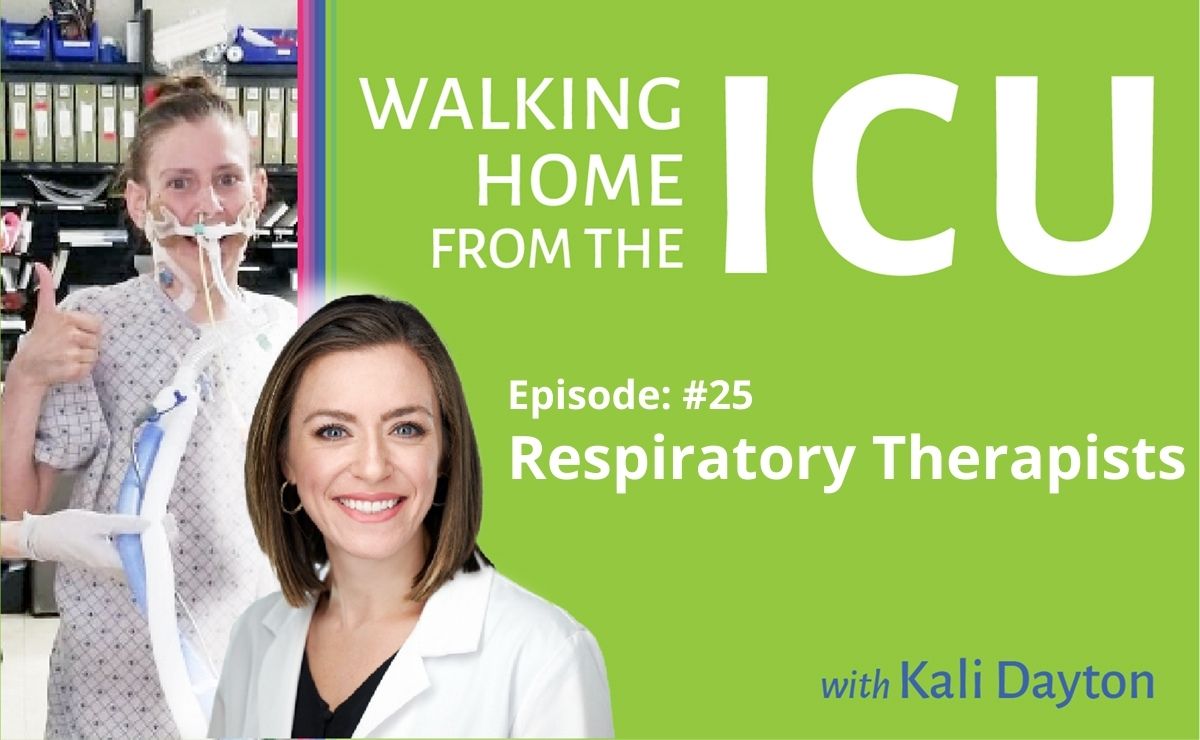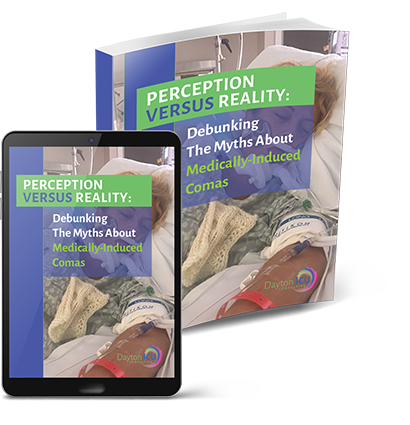SUBSCRIBE TO THE PODCAST
Kali talks with Cash, RRT, who shares his tips and secrets to walking and even showering patients on the ventilator. He reveals how having patients awake and walking has impacted his ICU career.
Episode Transcription
Kali Dayton
Cash thanks so much for joining us. So as a respiratory therapist Share with us your expertise, what is it like to care for patients that are awake on the ventilator?
Cash, RRT
Well, if they are awake, and they’re not delirious, it’s actually not too bad to work with them. For them. I mean, for the most part, here are the hospital we work out here, we, most of the time, do not sedate them, other than maybe for the procedure of doing the intubation and then you know, 10-15 minutes later they wake up.
Kali Dayton
And what does it like when they wake up?
Cash, RRT
At first though, they’ll definitely be uncomfortable as you would imagine having a tube down your throat. But, you know, the might have some coughing spells and a little bit of gagging for a few minutes trying to get used to it. Especially if they’re on assist control, uncomfortable at first and blowing CPAP pressures that they’re trying to breathe against, take some them a minute to get used to it.
But if the aren’t totally drugged out of their minds, then they can usually kind of use their brain to adjust themselves and they actually get comfortable fairly quickly. I would say, within 15 minutes or so they’re usually saying, “okay.”
Kali Dayton
Are they trying to there? Are they trying to pull the tube out after that?
Cash, RRT
You know, most of the time, we don’t see them trying to reach for it. There’s the occasional patient that you have to keep their hands tied down, but usually keep their hands tied down for the first little while, then they kind of come to terms with their situation.
And if their behavior as well enough, we actually many times untie their hands and let them be. And rarely have we ever had a problem with that. I can recall it once. And she was kind of terminal. And I think she was just done with it just intentionally, intentionally, yes, she was done.
Kali Dayton
But most people, are able to scratch their noses and suction their mouth.
Cash, RRT
Yeah. So they take part in their own care. I just hand them the yaunkeur and they clean out their mouths as they wish and not have to drool on themselves.
Kali Dayton
Isn’t that great? That’s what I would want. I wouldn’t want to lay there, feeling drool running down my face, and not being able to do anything about it. I didn’t think about that. Yeah, yeah, that’s a part of keeping them dignified. And how to control their situation. That’s a really good point.
And so you say, even on this control after 15 minutes or so they’re they’re able to cope with it. So how much ventilator dyssynchrony Is there when someone’s not sedated like that?
Cash, RRT
When they’re not sedated? I guess it depends on the case. Like if they’re, if their lungs are really bad, and you need to have a really high rate to keep their pH balanced or something like that, then they might have a hard time with having a high respiratory rate. But chances are they’re going to be breathing that fast on their own anyway. So their body’s telling them to. So even sometimes the higher rate, that’s what their body’s telling them to do. So we really don’t see too much dysynchrony, to be honest.
Kali Dayton
Yeah, that’s a great point. I think that’s a really common concern. For an understanding that sedation is to “avoid ventilator dysynchrony”.
But when have you seen ventilator to synchrony?
Cash, RRT
Honestly, I’m having a hard time…..
Somebody
Kali Dayton
Isn’t that great? What about when they’re coming off of sedation? Like if when we get patients from other places tha…
Cash, RRT
that’s about it. It’s that first 15 minutes when they’re just kind of coming to terms with their situation, trying to get used to it. It just takes a few minutes.
Kali Dayton
Or they’ve been sedated for days. And then it takes longer to clear out.
Cash, RRT
Yeah,,,and then they got those meds on board that kind of make your brain a little foggy and they don’t know what’s going on.
Kali Dayton
From what I’ve seen, in my experience is when we do sedation vacations or we start weaning off sedation, and suddenly, we’ve got really anxious patients because they’re delirious because they’re, like you said they don’t know what’s going on. Then we see a ventilator synchrony and there’s assumption that it’ll always be like that. But you suggest otherwise?
Cash, RRT
Yeah. Yeah.
Kali Dayton
So when they’re calm, cool, they’re not fighting the ventilator. And we’re able to get them up and walk them. What is it, like from your perspective, to walk a patient on a ventilator? And what’s your role in that?
Cash, RRT
Um, I was kind of my, the first time I came to this hospital, and they said, “We’re gonna get up and go walk,” I was like, “What are you talking about? Is this the wrong room, or what?” And they were like, “No, that’s what we do.”
“Okay, so you guys do this..” like, just plugged in some tanks and hook them up to the van. Away we go. Blew my mind. The first time I was like, “okay!” So, and we’ve seen almost every event patient that’s capable of walking, eventually will get up and walk.
Kali Dayton
How soon after they’re intubated?
Cash, RRT
Within a few hours, I mean, even just today. We had a patient that was intubated early this morning came through the ER, morning rounds come up. Doctor writes, in order for physical therapy to come and evaluate, and we’re walking at 10am.
Kali Dayton
Just hop to it.
Cash, RRT
Or if the patient is really just being intubated for like airway protection or something, and they wake up. And we’ve walked people within two, three hours, even.
Kali Dayton
What about when they’re leaving more ventilator support, or on higher ventilator settings?
Cash, RRT
Sometimes that can feel a little iffy to me, Honestly. Sometimes I don’t always agree with it. But I’m not the doctor. So I do what I’m told. So we go up, and we do it. And sure enough, they do just fine.
Kali Dayton
So sometimes you see those ventilator settings? And you it’s hard to imagine them being able to walk?
Cash, RRT
Yeah. So even with peeps of 16 to 20 it’s like, “what are we doing here? Are you’re trying to kill someone?”
Kali Dayton
Have you ever seen anything bad happen and the barotrauma? Ever heard of it?”
Cash, RRT
Nope. Never heard of it.
Kali Dayton
And how do you how do you support them during during that? So let’s say someone has a peep of 16? On 80%? How do you get them ready to walk?
Cash, RRT
Uh, well, since we only have one ventilator with the compressor, everybody pretty much walks on 100%.
Kali Dayton
Okay, that’s great, though.
Cash, RRT
Which is nice and oxygenated. So it’s harder for them to get short of breath, gives them all they can get for oxygen.
Depending on their settings, if they’re like already on CPAP, and I’ll add pressure support of 5, 10, 15, whatever they need, if they look like they’re starting to increase their work of breathing. You can increase support, just kind of on the fly as we’re going and try to make it so that they can use the rest of their body and not just get wiped out super quickly, fromthe respiratory standpoint.
Kali Dayton
Um, and what do you do beforehand, before you walk them?
Cash, RRT
First thing again when you get in the room, basically, just turn them up to 100%. Again, hyper oxygenated while we grab monitors and put the vent on the tanks and get everything ready, stand them up, get briefs on, do whatever we need to do give them a few minutes to get all hyper oxygenated. And then there and away we go.
Kali Dayton
And what about after?
Cash, RRT
Afterwards, generally try to put them back to their original left Fi02 to immediately and most of the time they do okay with that. Few exceptions when they have like some high settings, they might need a few more minutes. But generally, they can come back to their previous settings pretty quickly.
At most, I mean, you give them an hour tops and then going back to their original sevens. So this depends on the patient. Sometimes they’re okay immediately. Sometimes it takes a little bit of time to come back.
Kali Dayton
And you customize it for their needs.
Cash, RRT
Yeah.
Kali Dayton
What about secretion mobility?
Cash, RRT
I mean, anytime you get the body moving in different directions, it’s Gravity’s not a pole, sputum and phlegm from corners of the lungs and got it move on. I mean, whether they’re up and walking, which helps, sure. Even just rolling them side to side, doing bed care would get that moving as well. You definitely see some other walking as well.
Kali Dayton
Do you find yourself sectioning a lot more out after a walk?
Cash, RRT
We suction before we go walking, since you don’t have the ability to do all the walking, but then when you get back, a lot of times you end up doing it again and getting more out.
Kali Dayton
So yeah, it’s great.
Cash, RRT
Yeah, definitely helps us some secretion mobilization.
Kali Dayton
Um, how do patients tolerated it? the walking?
Cash, RRT
It’s kind of funny, I feel like a lot of it is attitude, maybe like patients just have a really hard time wanting to get up and understand you see all these lines in you and tubes and machines you’re like, and what, why do I have to do this? Yeah, just lay in bed and get better. And so a lot of times are fantastically positive physical therapists will have taught pep talk them for a few minutes. And basically, we don’t take no for an answer. We just keep talking. And until they finally say, “Fine, we’ll get up and walk. Let me do it.”
Kali Dayton
And are they coughing and gagging the whole time?
Cash, RRT
Are they? Yes, some of them? So sometimes it looks like it is not fun. Yeah. So you just carry a rag and catch their spit. And, but they do okay.
Kali Dayton
And they take breaks when they need to?
Cash, RRT
Yeah, always have a wheelchair behind them. So if they need to take a break and sit down, or if it’s getting to be too much to get busy, whatever. Treat as much symptoms as you can on the fly.
Kali Dayton
Do you think it’s safe to walk them on the ventilator?
Cash, RRT
Yeah, I don’t see I mean, in and of itself, just walking them just because they’re on a ventilator, and it’s fine. Like I say, sometimes those high settings feel a little iffy, or if they’re hemodynamically unstable, it feels a little iffy. Like, just yesterday, we have someone that has a fib. And so when he stands up, it triggers it and his heart rate shoots from 80 to 180. And we had a physician come in and look at it, we printed it out and EKG while he was doing it determines, yeah, it’s really high rate, but it’s not gonna cause him to have a heart attack. So let’s keep going on with the mobility,
Kali Dayton
He stayed stable, he was like not symptomatic, you’re able to continue to oxygenate..
Cash, RRT
He got a little symptomatic. And so when he gets dizzy or something, we let him sit down and recover. And when he sits down, his heart rate does come down quickly. So
Kali Dayton
Everyone’s followed with a wheelchair, and there’s always you know, that option to rescue if it’s needed. We’re not just following everyone with the whip, right? Um, you know, we do have some patients that are listening to music, and they’re kind of shaking and dancing, you know, while they’re walking.
And then we have some people that can walk five feet at a time and need a break. And so every patient, every case is different. I never mean to make it sound like people are just skipping through the halls of their ventilators, though some are pretty close. But I think they do appreciate being able to take showers. So tell us your secret. That’s what a lot of people want to know, how do you get a patient on a ventilator into the shower,
Cash, RRT
If we have time to kind of low patient senses, because then I got to stand there for 30 minutes or however long it takes into the shower. But basically, I just go grab some extra corrugated tubing that’s like 10-15 feet long that I can take. And just add on to the ventilator circuits. It’s got a little adapter and put it in line. So it also don’t like to do that with people that are on really high PEEP. Right? Yeah, so it’s patient dependent, as well. But it’s also not great for long term, but you know, for 15-20 minutes, it’s okay. Soon, as soon as they come out of the shower, they take all that long tubing off. But I’ve never had an issue with it.
Kali Dayton
What do you think that does for patients? Or what do you what do they look like afterward?
Cash, RRT
I couldn’t imagine not taking the shower for I mean, some of these people are in here for a month. If they’re a ARDS or something like that, yeah. Imagine not taking a shower for a month?
Kali Dayton
Oh, no, it would drive me crazy. I feel like it’s, that’s like a psychological necessity.
Cash, RRT
Yeah.
Kali Dayton
And if these people you know, they’re awake, they know what’s going on. And just what I see them rolling out in wheelchairs, you know, we walk them to the shower and they roll out. They just have a glow about them. Not just a wet shimmer, but they just, you can tell that they feel better. They feel more like themselves.
Cash, RRT
Yeah, yeah. Instead of just a patient. Yeah.
Kali Dayton
That’s a really good way to put it. I feel like a person not just the patient What does that mean to you to be able to provide that kind of quality of care and that kind of that kind of difference for a patient?
Cash, RRT
It’s definitely more fulfilling and rewarding to take care of patients that you feel like you’re kind of going the extra mile for. Whereas if they were just in your regular hospital, they just say, “Sorry, we just do shower caps and rags.”
Kali Dayton
Yeah, so you know, probably wouldn’t cut it for me. But when someone’s just comatose, there is no option. Yeah, well, what does it mean to you to know that 98% of your surviving patients go straight home? What role do you think you’ve played in that?
Cash, RRT
As a bedside careworker? We really, at least I don’t ever hear of any statistics or anything like that. So whenever we do hear something like that, it’s a kind of what’s the word? It makes it feel like you’re doing something?
Kali Dayton
Like it’s all for something.
Cash, RRT
Yeah, like it kind of comes together in the big picture is what it kind of feels like. So it’s, you come to work every day. And it just sometimes feels like another day at work. But when you see the big picture, and it’s like, all this work is paying off and you’re seeing great results overall. It kind of drives the picture home that you’re making a difference.
Kali Dayton
Yeah, and I think you and all of respiratory therapy make a huge difference. I think you guys are one of the big heroes here in the ICU. The fact that hardly any of our patients have tracheostomies or go to long term care facilities really comes down to you and physical therapy and the nurses going the extra mile, genuinely caring and getting people up and walking right away and throughout their critical illness. So thank you for all that you do, the big difference that you make, and for sharing your expertise and trade secrets with us. Thanks, Cash!
Transcribed by https://otter.ai
SUBSCRIBE TO THE PODCAST




